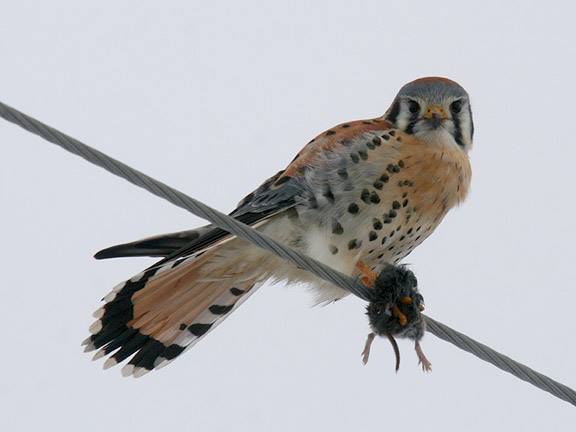In her many years of observing raptors in Utah, Robyn MacDuff has had some remarkable encounters with birds. While hiking in the cliffs above the Green River in the Moab area last November, she and her companion took a break in the rocks on the rim above the canyon.
“We were just sitting there, and it was kind of a cloudy day, and a golden eagle flew right over the top of us,” MacDuff recalled. “He was like, 25 feet above our heads. He just flies by like, ‘Oh, what are you guys doing?’”
MacDuff, director of the nonprofit Raptor Inventory Nest Survey (RINS) can’t guarantee thrills like this to volunteers who collect data for survey, but they are a possibility.
The Bureau of Land Management (BLM) and RINS will be hosting two training workshops this month, one in Moab and one in Monticello, for people interested in participating in the survey. The workshops will familiarize volunteers with the standardized observation protocols and develop their bird identification skills.
The first workshop is scheduled to be held on Tuesday, Jan. 30, from noon to 4:30 p.m., at the BLM Moab field office, 82 E. Dogwood. The next workshop is set to be held the following day, Jan. 31, from noon to 4:30 p.m., at the BLM Monticello field office, 365 N. Main St., in Monticello.
Participants are asked to commit two days per month, from February to June, to monitoring an assigned area, observing bird behavior and nest sites and recording data. No prior knowledge or experience are required to take part.
“We encourage any and all people who are interested and want to learn more about raptors, want to learn more about the outdoors – small mammals, reptiles, butterflies…” MacDuff said.
The data collection protocol includes observations made on habitat and prey, and is an opportunity to explore all aspects of the ecosystem.
RINS has been recording data on raptors in Utah since 2000. In the spring of that year, land managers announced that they no longer had the funding to monitor known nest sites in northern Utah. In response, concerned scientist Dawn Sebesta organized a group of volunteers to continue observing the nests, and eventually created the RINS nonprofit. The organization has grown to include 1,200 volunteers and cover 19 Utah counties.
RINS partners with the Bureau of Land Management to organize volunteers and to act on the data they collect. The BLM doesn’t have the manpower or the funding to gather the extensive data collected by RINS, MacDuff explained, so it is happy to cooperate with the organization.
“RINS has been an excellent partner,” said Lisa Bryant, assistant manager of the Moab BLM field office. “And the BLM uses the information gathered by volunteers to help make decisions. The work volunteers do is greatly appreciated and helps protect these magnificent birds.”
Pam Riddle, the wildlife biologist for the BLM in Moab, agreed.
“The BLM is committed to keeping public lands productive and providing healthy habitat for raptors and other wildlife,” she said in a press release. “Information gathered by RINS volunteers aids managers in protecting nest sites and young birds.”
Observations made by RINS volunteers may prompt actions such as installing signs alerting the public to nesting activity and asking that outdoor recreationists avoid disturbing the birds. Signs like this can be very effective, particularly in a place like Moab, where people value the natural landscape and want to protect it.
“They don’t want to compromise the resource,” MacDuff said, “so people are pretty easily alerted and they take the proper actions and modify what they’re doing for a while, just for the nesting season.”
MacDuff appreciates the BLM’s commitment to protecting wildlife and hopes it will remain a priority over increased development.
“There’s a direct correlation between human activity, and loss of habitat and declining raptor numbers – that has been proven over and over again in many scientific studies,” she said.
MacDuff conducts the trainings, and periodically visits areas being monitored throughout the time-frame of the survey, providing support for volunteers. Participants may find her enthusiasm contagious.
“They’re fascinating, their ecology,” she said of the birds. “… The way they nest and the way they take care of their young and the way they take care of each other when they’re nesting – in the nesting season the males feed the females. They’re just amazing. I think human beings could take a lesson in parenting, watching a raptor nest from start to finish.”
Volunteers wanted to help monitor local birds of prey populations
What: Raptor Inventory Nest Survey volunteer training workshops
When: Tuesday, Jan. 30, from noon to 4:30 p.m. and Wednesday, Jan. 31, from noon to 4:30 p.m.
Where: Moab BLM field office at 82 E. Dogwood (Jan. 30); and Monticello BLM field office at 365 N. Main St. in Monticello (Jan. 31)
Cost: Free
Information: www.rins.org, or email info@rins.org, or call 801-554-0807
They’re just amazing. I think human beings could take a lesson in parenting, watching a raptor nest from start to finish.
For more information, go to: www.rins.org, email info@rins.org, or call 801-554-0807.




